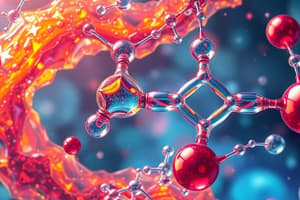Podcast
Questions and Answers
What is the general molecular formula for an acyclic alkyne?
What is the general molecular formula for an acyclic alkyne?
CnH2n-2
How is the systematic name of an alkyne obtained?
How is the systematic name of an alkyne obtained?
By replacing the 'ane' ending of the alkane name with 'yne'
What is the difference between a terminal alkyne and an internal alkyne?
What is the difference between a terminal alkyne and an internal alkyne?
A terminal alkyne has the triple bond at the end of the chain, while an internal alkyne has the triple bond located elsewhere along the chain.
How are alkynes named in common nomenclature?
How are alkynes named in common nomenclature?
What is a unique property of alkynes found in nature?
What is a unique property of alkynes found in nature?
What is a common characteristic of alkynes in terms of solubility?
What is a common characteristic of alkynes in terms of solubility?
Why do alkynes have higher boiling points than alkenes with the same number of carbons?
Why do alkynes have higher boiling points than alkenes with the same number of carbons?
What type of orbital is used to form the carbon-carbon σ bond between two highlighted carbons in an alkyne?
What type of orbital is used to form the carbon-carbon σ bond between two highlighted carbons in an alkyne?
What is the product of 1-addition of hydrogen halide to an alkyne?
What is the product of 1-addition of hydrogen halide to an alkyne?
What is the product of 2-addition of water to an alkyne?
What is the product of 2-addition of water to an alkyne?
Flashcards are hidden until you start studying
Study Notes
Alkynes
- An alkyne is a hydrocarbon that contains a carbon-carbon triple bond.
- Only relatively few alkynes are found in nature, with examples including capillin and ichthyothereol.
- Alkynes have four fewer hydrogens than an alkane with the same number of carbons.
- The general molecular formula for an acyclic alkyne is CnH2n-2, and for a cyclic alkyne is CnH2n-4.
- Systematic names of alkynes are obtained by replacing the “ane” ending of the alkane name with “yne.”
Nomenclature
- The longest continuous chain containing the carbon-carbon triple bond is numbered in the direction that gives the functional group suffix as low a number as possible.
- Alkynes with triple bonds located at the end of the chain are classified as terminal alkynes.
- Alkynes with triple bonds located elsewhere along the chain are internal alkynes.
- In common nomenclature, alkynes are named as substituted acetylenes.
- The common name is obtained by stating the names of the alkyl groups (in alphabetical order) that have replaced the hydrogens of acetylene.
Physical Properties
- All hydrocarbons (alkanes, alkenes, and alkynes) have similar physical properties.
- They are all insoluble in water but soluble in nonpolar solvents.
- They are less dense than water and have boiling points that increase with increasing molecular weight.
- Alkynes are more linear than alkenes, and a triple bond is more polarizable than a double bond.
- These features cause an alkyne to have stronger van der Waals interactions and, therefore, a higher boiling point than an alkene with the same number of carbons.
Reactions of Alkynes
- 1-addition of hydrogen halide to an alkyne:
- 2-addition of water:
- 2-addition of hydrogen:
Studying That Suits You
Use AI to generate personalized quizzes and flashcards to suit your learning preferences.




